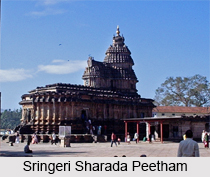 Sringeri Sharada Peetham in a ancient Hindu monastery established by Adi Shankaracharaya in 8th century AD, that is in the early phase of medieval era and the later phase of ancient times.
Sringeri Sharada Peetham in a ancient Hindu monastery established by Adi Shankaracharaya in 8th century AD, that is in the early phase of medieval era and the later phase of ancient times.
Location of Sringeri Sharada Peetham
Sringeri Sharada Peetham is on the banks of the Tunga River in Chikkamagalur district, Karnataka, India, 105 kilometres from Mangaluru and 303 kilometres from the state capital Bengaluru.
Establishment of Sringeri Sharada Peetham
Sringeri Sharada Peetham is the southern Advaita Vedanta matha or monastery established by Adi Shankara in 8th century AD.
Members in Sringeri Sharada Peetham
The majority of members of Smartha community follow the Advaita Vedanta philosophy of Adi Shankara. Smarta and Advaita have become almost synonymous, though not all Advaitins are Smartas. Traditionally, Shankara of the 8th century is regarded as the greatest teacher and reformer of the Smartha. According to Hiltebeitel, Shankara established the no dualist interpretation of the Upanishads as the touchstone of a revived smarta tradition. The Sringeri Sharada monastery founded by Shankara in Karnataka is still the centre of the Smarta sect.
Management of Sringeri Sharada Peetham
The head of Sringeri Sharada Peetham or Guru Parampara is venerated as Jagadguru. The head has so far been chosen by the prevailing pontiff usually from among his disciples usually chosen as a Brahmachari, educated in the Vedas and other required learning. Succession to the Sankaracharya title is through disciple selection by the existing Sankaracharya. The successor to the matha is usually named at a young age, from among the Vedic Brahmana community.
Inscriptions in Sringeri Sharada Peetham
Sringeri Sharada Peetham records its tradition from the 8th century onwards. The history of the Sringeri matha since the period of Sri Bharathi Tirtha (I) and Sri Vidyaranya (14th century) onwards has been documented. Most of the names from the Sringeri lineage up to Vidyaranya are also found in the Sri Guru Charitra, a 15th-century Marathi work by Gangadhara Saraswathi. The idol of Sureshwaracharya, who was Madan Mishra in his purvashrama, was installed here as the successor of Shankaracharya before the latter resumed his tour to found his three pithas at Puri, Dwaraka and Badrinath.
Successors of Sringeri Sharada Peetham
Vidushekara Bharathi Swami has been appointed as the real successor of the Sringeri Sharadha Peetham coronate by Sree Bharati Theertha Maha Swamigal.





















